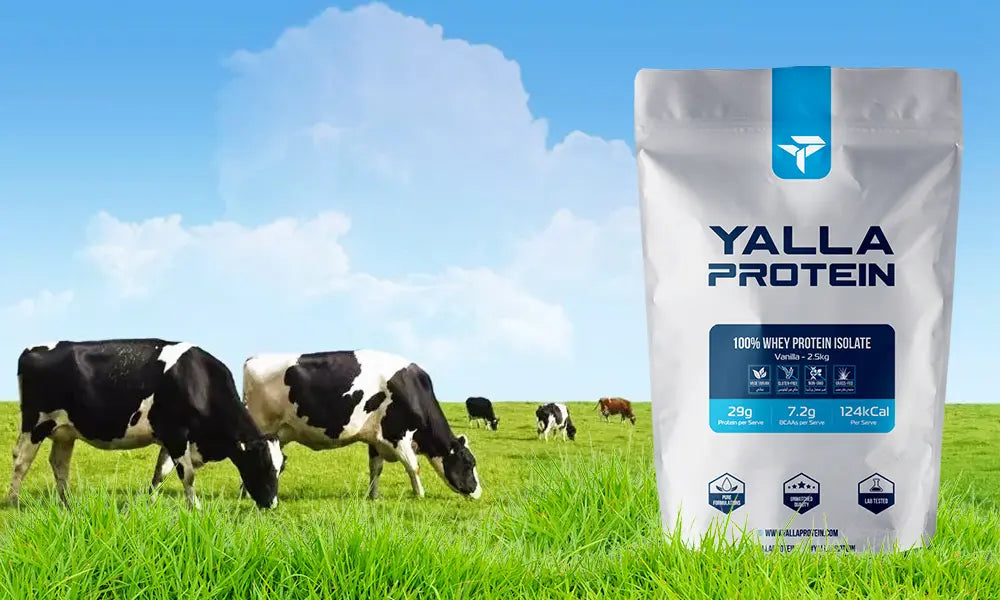Benefits Of Grass Fed Whey Protein Isolate

Grass fed cattle used to be the norm, up until about 80 years or so ago. However, modern consumption habits (notably a rise in demand for cheap meat and dairy) changed this in the 1940s. Dairy farmers had to find a way to improve efficiency of production.
This meant finding an alternative food source. Nowadays, most cattle are fed a predominantly grain-based diet and treated with hormones in order to fatten them up. This is an incredibly profitable method of raising them but isn’t the best for either the cows themselves or the consumers who drink their milk.
Meat and dairy sourced from cows raised on a grass-fed diet is significantly higher in nutritional value than that from cows who are grain-fed. Aside from the added micro nutritional content inherent to living on grass rather than grains, grass-fed diets promote a healthier pH internal balance in the cows’ guts, which then provides beneficial bacteria.
These advantages are passed on to the milk and, from there, to the 100% Whey Protein Isolate (WPI) made from the milk.
Grass-fed WPI will bring about great results when used as a supplement to a healthy diet and as part of an active lifestyle. It will allow you to build muscle whilst remaining lean, satisfying your protein requirements without overloading you with calories.
Most grass-fed WPI will also be free of artificial ingredients and flavours and should also contain minimal to no bulking agents. All in all, grass-fed WPI should represent a natural, healthier option than standard whey.
Overall, there are three specific reasons that you should consider switching to grass-fed WPI:
1. It Aids Exercise Recovery and Hypertrophy
Consuming a good quality, hormone free, grass-fed WPI after training will help to improve hypertrophy (muscle growth) efficiency and strength adaptation, whilst making your recovery more efficient with minimized muscle damage and delayed onset of muscle soreness (DOMS).
To make the most of the benefits of going grass-fed, keep the other ingredients you use in your protein shake to a similar standard. Try blending it with organic milk or almond milk and organic fruit and vegetables.
Try this recipe for a good example:
- 50g grass-fed WPI
- handful of blueberries
- chopped banana
- half an avocado
- drop of vanilla essence
- 300ml organic, semi-skimmed milk
- handful of oats
Blend them all together, giving you a nice mixture of complex and simple carbs (from the milk, oats and fruit), to replace the glycogen used during training, fat (from the avocado) to promote healthy joints and hormonal function, and protein (from the WPI itself, with a small amount in the oats and milk) to fuel hypertrophy. The vanilla essence will add a touch of sweetness and draw all the other flavours together.
As a side note, the greater nutrient availability and healthy gut bacteria (see below) promoted by grass-fed livestock products will lead to an improved immune system. They will also generally contain no antibiotics, meaning that you won’t build up a tolerance to antibiotics. This means both that you will get sick less often and, when you do get sick, antibiotics will work far more efficiently for you.
2. It Aids Weight Loss and Re-composition
100% Whey Protein Isolate may aid weight loss when combined with a healthy diet, comprising a caloric deficit, in tandem with an active lifestyle. Whilst all whey can fulfil this role, spiking protein intake to fuel muscle growth with few added calories, eliciting greater satiation and acting as a base component for a good-quality meal replacement shake, grass-fed WPI has a few extra tricks up its sleeve in this department.
Firstly, it contains up to 5 times more of the fatty acid conjugate linoleic acid (CLA) compared to most commercially available whey. CLA has been shown to improve hypertrophy efficiency and boost the metabolism. These are both vital for weight loss. In addition, this double assault will make recomposition more attainable- whereby you lose weight and gain muscle at the same time.
Secondly, the healthy gut bacteria enjoyed by grass fed cows will lead to greater biodiversity in their whey (see below). This in turn will promote healthier gut bacteria for grass-fed WPI consumers. Healthy gut composition is also a key weight loss aid, will improve digestive health and will lead to greater feelings of satiation (making a caloric deficit easier to stick to).
3. Higher Biological Value
All WPI provides a complete amino acid profile, including all nine essential amino acids, which is vital for muscle growth. This is a large part of the reason that whey is often favoured over plant-based protein powders like soy or pea.
In addition to this, grass-fed WPI provides the consumer with an optimal biological value and a far higher concentration (about 25%) of branched-chain amino acids (BCAAs) compared to non-whey protein products.
BCAAs are the three amino acids leucine, isoleucine, and valine. They are vital for overall health and muscular growth in particular, as they are precursors for the synthesis of the amino acids glutamine and alanine. The body uses these two amino acids during exercise, depleting them quite rapidly.
In addition to this, valine and isoleucine can be used as energy sources during intense exercise. Studies have shown that BCAAs provide important energy during. They also suggest that BCAAs can prevent muscle protein breakdown. For these reasons, they are common supplements for athletes and bodybuilders alike.
Grass-fed dairy also provides greater nutrient availability and will deliver more omega-3 fatty acids than standard whey products. Omega-3 acids are crucial for athletes as they have an anti-inflammatory effect and will lead to improved joint health. Inflammation is one of the key factors contributing to DOMS and exercise fatigue: combating it will therefore aid recovery. Joint pain, especially long-term, chronic pain, is an issue that many athletes face, making omega-3 worthy of inclusion in any dietary protocol.

